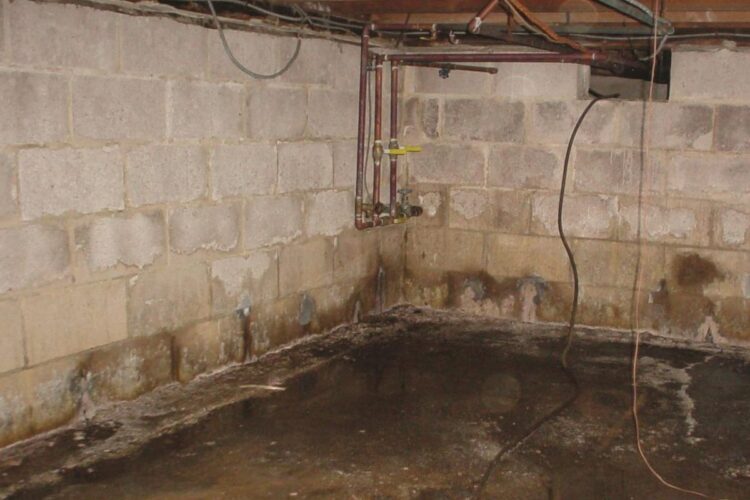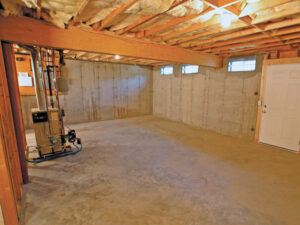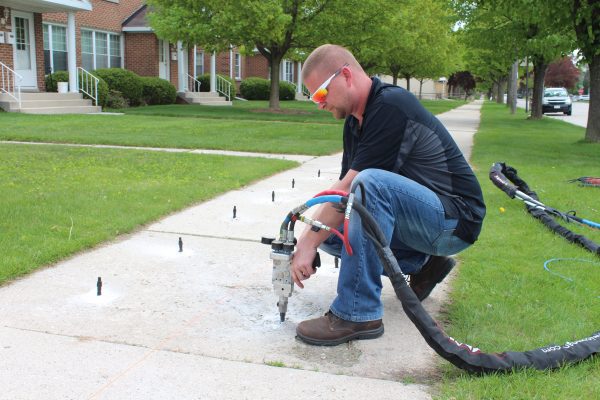
- By Christian Sundahl
- In basement waterproofing, Basement Waterproofing Methods, Bowed basement walls, Crawlspace Waterproofing, foundation repair, foundation wall cracks, foundation waterproofing, indoor air quality, Sundahl Waterproofing
- Tags Foundation waterproofing
Foundation Waterproofing Techniques: Protecting Your Home’s Lifeline
A solid foundation is the cornerstone of any sturdy and resilient home. It provides structural stability, supports the entire building, and safeguards against soil pressure, moisture intrusion, and other external factors. However, one of the most common threats to a foundation’s integrity is water damage. Foundation waterproofing techniques play a crucial role in preventing this issue, ensuring the longevity and safety of your home.
In this comprehensive guide, we will explore the importance of foundation waterproofing, the various techniques available, and the steps you can take to protect your home from water-related foundation problems.
The Significance of Foundation Waterproofing
Water is a relentless force of nature that can infiltrate even the tiniest of cracks in your foundation, causing a multitude of problems. These issues include:
- Structural Damage: Water seeping into your foundation can weaken the concrete, erode the soil beneath it, and ultimately compromise the structural integrity of your home.

- Mold and Mildew Growth: Excess moisture can create a conducive environment for mold and mildew to thrive, posing serious health risks to your family and causing extensive damage to your property.
- Basement Flooding: Water infiltration can lead to basement flooding, damaging your belongings and requiring costly repairs.
- Decreased Property Value: A compromised foundation due to water damage can significantly decrease your home’s value when you decide to sell it.
Foundation Waterproofing Techniques
Fortunately, there are several effective foundation waterproofing techniques available to protect your home from water-related issues. These techniques can be categorized into two main types: exterior and interior waterproofing methods. Let’s explore these methods in detail.
Exterior Foundation Waterproofing
- Exterior Waterproofing Membrane:
- Common materials used for this purpose include asphalt-based coatings, rubberized asphalt, and cementitious waterproofing.
- The membrane forms a barrier that prevents water from penetrating the foundation walls.
- Drainage Systems:
- Proper drainage is essential to direct water away from the foundation. French drains and footing drains are common exterior drainage systems.
- French drains consist of a perforated pipe installed around the foundation, which collects water and channels it away from the home.
- Footing drains are placed at the base of the foundation walls to intercept groundwater and divert it away from the foundation.
- Exterior Excavation:
- In cases where severe water issues exist, exterior excavation may be necessary.
- This involves digging around the foundation, allowing access to the exterior walls.
- Waterproofing materials are applied, and drainage systems are installed before backfilling the excavated area.
- Dimpled Membrane:
- Dimpled membranes are plastic sheets with raised dimples that create an air gap between the foundation wall and the surrounding soil.
- This space allows water to drain away from the foundation while preventing it from coming into direct contact with the wall.
Interior Foundation Waterproofing
- Interior Drainage Systems:
- Interior drainage systems are installed on the inside of the basement or crawl space.
- They include the installation of a drainage channel along the perimeter of the space, leading to a sump pump.
- The sump pump then pumps water out of the home to prevent flooding.
- Epoxy or Polyurethane Injection:
- This technique is used to seal cracks and joints in the foundation walls from the inside.
- Interior Waterproofing Coatings:
- Interior waterproofing coatings, such as waterproof paints and sealants, are applied to the interior surface of the foundation walls.
- While not as effective as exterior methods, they can provide an extra layer of protection against moisture.
Choosing the Right Waterproofing Technique
The choice between exterior and interior foundation waterproofing techniques depends on several factors, including the severity of the water issue, your budget, and the specific characteristics of your home. Here are some considerations to help you make an informed decision:
- The severity of the Problem:
- For minor dampness or moisture issues, interior waterproofing methods may be sufficient.
- Severe water problems, such as basement flooding, typically require exterior waterproofing.
- Budget Constraints:
- Exterior waterproofing can be more expensive due to excavation and labor costs.
- Interior methods are often more budget-friendly.
- Landscape and Property Layout:
- The layout of your property, including landscaping and obstacles, can affect the feasibility of exterior waterproofing.
- Sloping terrain may make it easier to implement exterior drainage solutions.
- Existing Structures:
- Consider the presence of finished basements or other structures that may make interior waterproofing the more practical choice.
Steps to Ensure Effective Foundation Waterproofing
Whether you choose exterior or interior waterproofing methods, here are essential steps to ensure that your foundation remains protected:
- Professional Inspection:
- Start by hiring a professional to inspect your foundation and assess the extent of any existing water damage or potential vulnerabilities.
- Regular Maintenance:
- Periodically inspect and maintain your foundation, including checking for cracks and sealing them promptly.
- Clean and maintain your drainage systems to prevent clogs and blockages.
- Sump Pump Maintenance:
- If you have an interior drainage system with a sump pump, regularly test and maintain it to ensure it functions correctly.
- Landscaping:
- Consider the landscaping around your home. Avoid planting trees or shrubs with extensive root systems near your foundation, as they can damage it over time.
Foundation waterproofing is a critical aspect of maintaining the structural integrity and longevity of your home. Neglecting to protect your foundation from water damage can lead to costly repairs, health hazards, and decreased property value. Whether you opt for exterior or interior waterproofing techniques, consulting with professionals and taking proactive measures will ensure that your home remains a safe and secure haven for years to come. Protecting your home’s lifeline is an investment that pays off in peace of mind and long-term value.
inst soil pressure, moisture intrusion, and other external factors. However, one of the most common threats to a foundation’s integrity is water damage. Foundation waterproofing techniques play a crucial role in preventing this issue, ensuring the longevity and safety of your home.
In this comprehensive guide, we will explore the importance of foundation waterproofing, the various techniques available, and the steps you can take to protect your home from water-related foundation problems.
The Significance of Foundation Waterproofing
Water is a relentless force of nature that can infiltrate even the tiniest of cracks in your foundation, causing a multitude of problems. These issues include:
- Structural Damage: Water seeping into your foundation can weaken the concrete, erode the soil beneath it, and ultimately compromise the structural integrity of your home.
- Mold and Mildew Growth: Excess moisture can create a conducive environment for mold and mildew to thrive, posing serious health risks to your family and causing extensive damage to your property.
- Basement Flooding: Water infiltration can lead to basement flooding, damaging your belongings and requiring costly repairs.
- Decreased Property Value: A compromised foundation due to water damage can significantly decrease your home’s value when you decide to sell it.
Foundation Waterproofing Techniques
Fortunately, there are several effective foundation waterproofing techniques available to protect your home from water-related issues. These techniques can be categorized into two main types: exterior and interior waterproofing methods. Let’s explore these methods in detail.
Exterior Foundation Waterproofing
- Exterior Waterproofing Membrane:
- Common materials used for this purpose include asphalt-based coatings, rubberized asphalt, and cementitious waterproofing.
- The membrane forms a barrier that prevents water from penetrating the foundation walls.
- Drainage Systems:
- Proper drainage is essential to direct water away from the foundation. French drains and footing drains are common exterior drainage systems.
- French drains consist of a perforated pipe installed around the foundation, which collects water and channels it away from the home.
- Footing drains are placed at the base of the foundation walls to intercept groundwater and divert it away from the foundation.
- Exterior Excavation:
- In cases where severe water issues exist, exterior excavation may be necessary.
- This involves digging around the foundation, allowing access to the exterior walls.
- Waterproofing materials are applied, and drainage systems are installed before backfilling the excavated area.
- Dimpled Membrane:
- Dimpled membranes are plastic sheets with raised dimples that create an air gap between the foundation wall and the surrounding soil.
- This space allows water to drain away from the foundation while preventing it from coming into direct contact with the wall.
Interior Foundation Waterproofing
- Interior Drainage Systems:
- Interior drainage systems are installed on the inside of the basement or crawl space.
- They include the installation of a drainage channel along the perimeter of the space, leading to a sump pump.
- The sump pump then pumps water out of the home to prevent flooding.
- Epoxy or Polyurethane Injection:
- This technique is used to seal cracks and joints in the foundation walls from the inside.
- Interior Waterproofing Coatings:
- Interior waterproofing coatings, such as waterproof paints and sealants, are applied to the interior surface of the foundation walls.
- While not as effective as exterior methods, they can provide an extra layer of protection against moisture.
Choosing the Right Waterproofing Technique
The choice between exterior and interior foundation waterproofing techniques depends on several factors, including the severity of the water issue, your budget, and the specific characteristics of your home. Here are some considerations to help you make an informed decision:
- The severity of the Problem:
- For minor dampness or moisture issues, interior waterproofing methods may be sufficient.
- Severe water problems, such as basement flooding, typically require exterior waterproofing.
- Budget Constraints:
- Exterior waterproofing can be more expensive due to excavation and labor costs.
- Interior methods are often more budget-friendly.
- Landscape and Property Layout:
- The layout of your property, including landscaping and obstacles, can affect the feasibility of exterior waterproofing.
- Sloping terrain may make it easier to implement exterior drainage solutions.
- Existing Structures:
- Consider the presence of finished basements or other structures that may make interior waterproofing the more practical choice.
Steps to Ensure Effective Foundation Waterproofing
Whether you choose exterior or interior waterproofing methods, here are essential steps to ensure that your foundation remains protected:
- Professional Inspection:
- Start by hiring a professional to inspect your foundation and assess the extent of any existing water damage or potential vulnerabilities.

- Start by hiring a professional to inspect your foundation and assess the extent of any existing water damage or potential vulnerabilities.
- Regular Maintenance:
- Periodically inspect and maintain your foundation, including checking for cracks and sealing them promptly.
- Clean and maintain your drainage systems to prevent clogs and blockages.
- Sump Pump Maintenance:
- If you have an interior drainage system with a sump pump, regularly test and maintain it to ensure it functions correctly.
- Landscaping:
- Consider the landscaping around your home. Avoid planting trees or shrubs with extensive root systems near your foundation, as they can damage it over time.
Foundation waterproofing is a critical aspect of maintaining the structural integrity and longevity of your home. Neglecting to protect your foundation from water damage can lead to costly repairs, health hazards, and decreased property value. Whether you opt for exterior or interior waterproofing techniques, consulting with professionals and taking proactive measures will ensure that your home remains a safe and secure haven for years to come. Protecting your home’s lifeline is an investment that pays off in peace of mind and long-term value.
Contact the Professionals at Sundahl Waterproofing Today! (914) 639-6344






